Last updated on January 31st, 2024.
When it comes to breakfast pastries, the realm of possibilities is “to infinity and beyond” (I always wanted to say that). Among the many delightful options, Brioche Croissants stand out as a luxurious and indulgent treat.
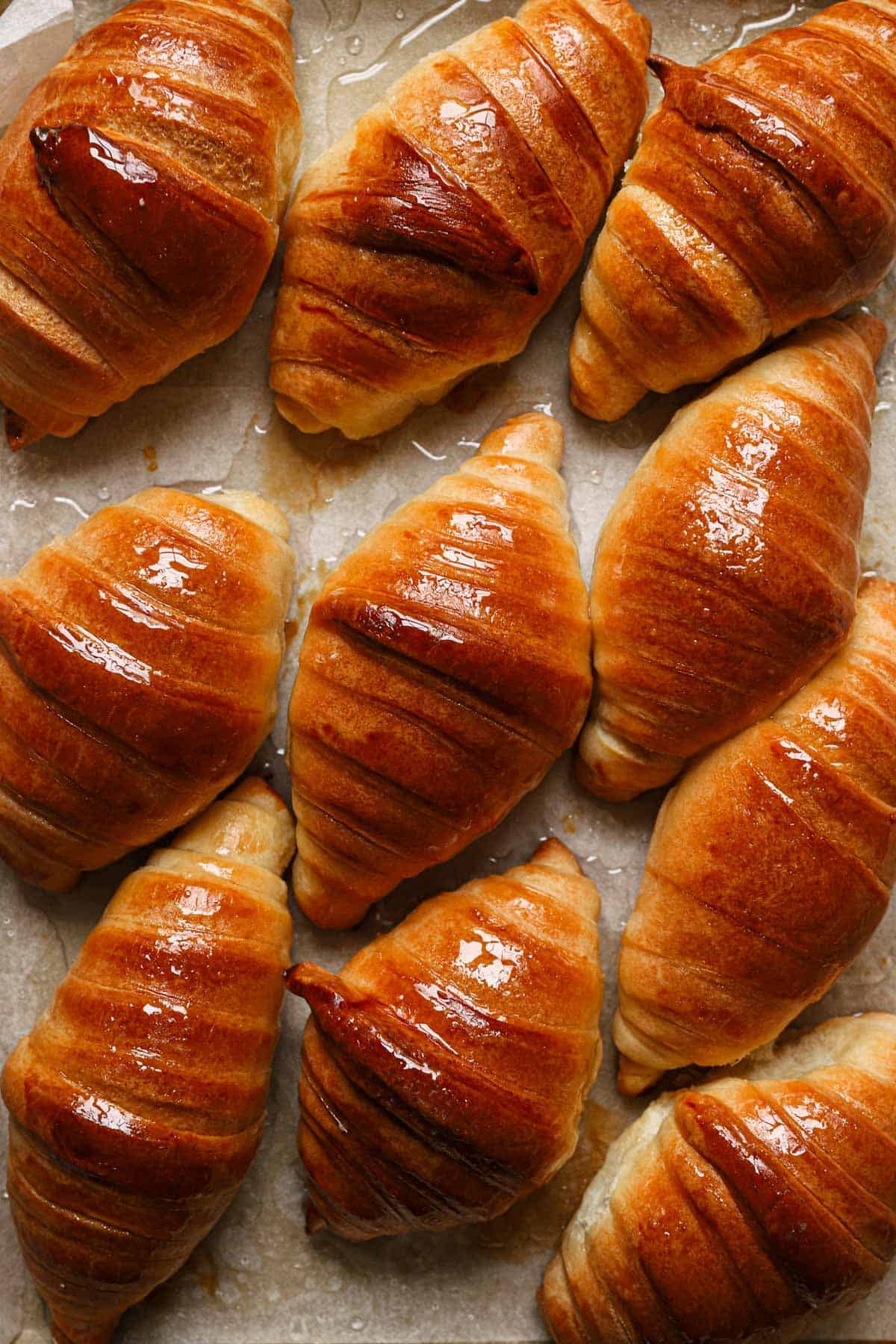
Brioche Croissants vs. Croissants
What sets them apart?
Traditional croissants are known for their flaky texture and buttery layers, which are produced by laminating our dough with a block of butter. With Brioche Croissants (closer to Portuguese Croissants), we essentially use enriched brioche dough, skip the laminating process, and incorporate the butter into the dough during the mixing and shaping process. I mean, making flaky Croissants or Cornetti from scratch is a very rewarding bake. But sometimes, we want to skip the process; it’s not laziness. It’s called taking advantage of the epitome of convenience baking.
Ingredients
To embark on the journey of crafting these divine pastries, gather the following ingredients:
For The Dough
- All-purpose wheat flour. Make sure you only use unbleached all-purpose flour.
- Bread flour. If you do not have any, use all unbleached purpose flour.
- Sugar
- Salt
- Instant yeast
- Water or milk.
- Eggs. At room temperature
- Unsalted butter, softened. Some for the dough and some for the filling. Do not use salted butter.
For The Syrup
The syrup is optional, but I think it adds another sticky layer and sweetness.
- Water
- Sugar
- Vanilla extract
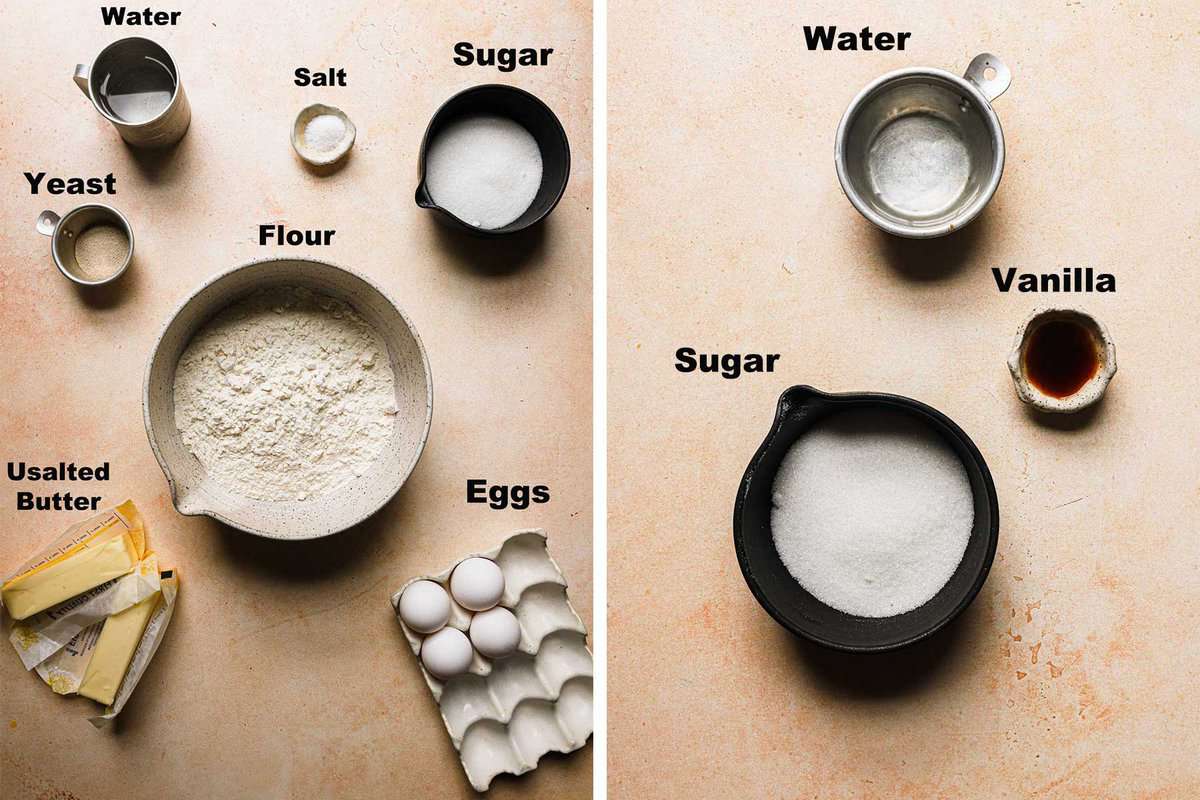
How to Make Brioche Croissants
Make The Dough
For more tips, check out my ultimate guide for How To Make Brioche Dough.
- Place the flour, yeast, salt, and sugar in a large bowl, and add the eggs and water with the mixer on medium-low.
- Mix for about three minutes until you have a dense, slightly dry dough.
- With the mixer on medium speed, add the butter one piece at a time, waiting for the butter to mostly incorporate before adding the next.
- Continue mixer on medium-high using the dough hook until the edges of the bowl are dough-free and you have a smooth, elastic, buttery dough.
- Divide the dough into two equal parts, cover with plastic wrap, and refrigerate overnight.
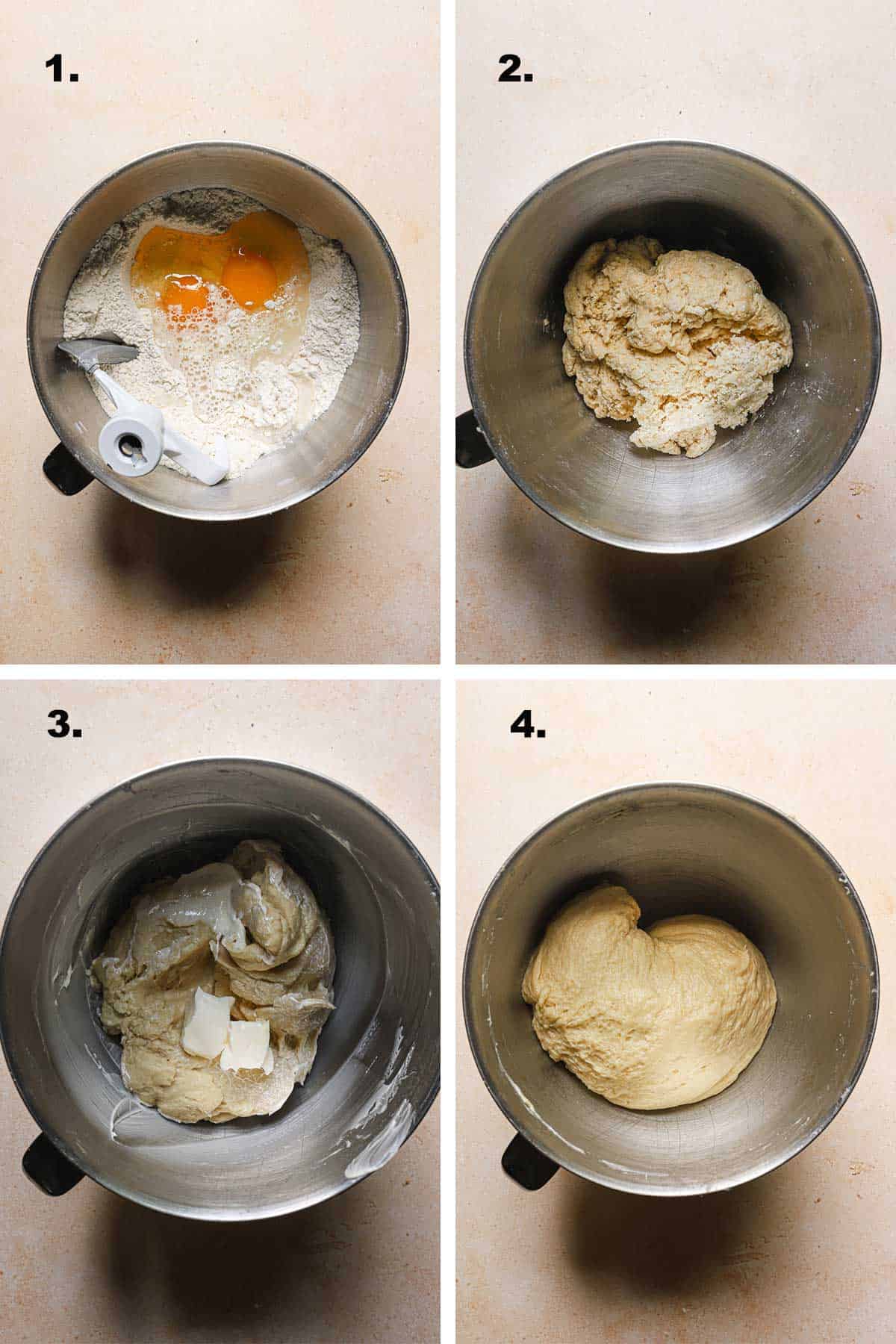
Shaping
- Divide the dough into two. Place one part over a lightly floured surface, and use your finger to press it into one inch thick.
- Roll the dough into an 18×9-inch rectangle using a rolling pin, then mark the wide side every three inches.
- Gently spread the soft butter over the surface of the dough into an even and thin layer.
- Use a sharp knife to cut the dough diagonally from the bottom (3-inch mark) towards the corner of the other side and back.
- Roll the croissant dough starting from the wide end while gently stretching it.
- Place the pastries over a baking sheet lined with parchment paper, brush with egg wash, and allow to rest until double in size. (about 2-3 hours)
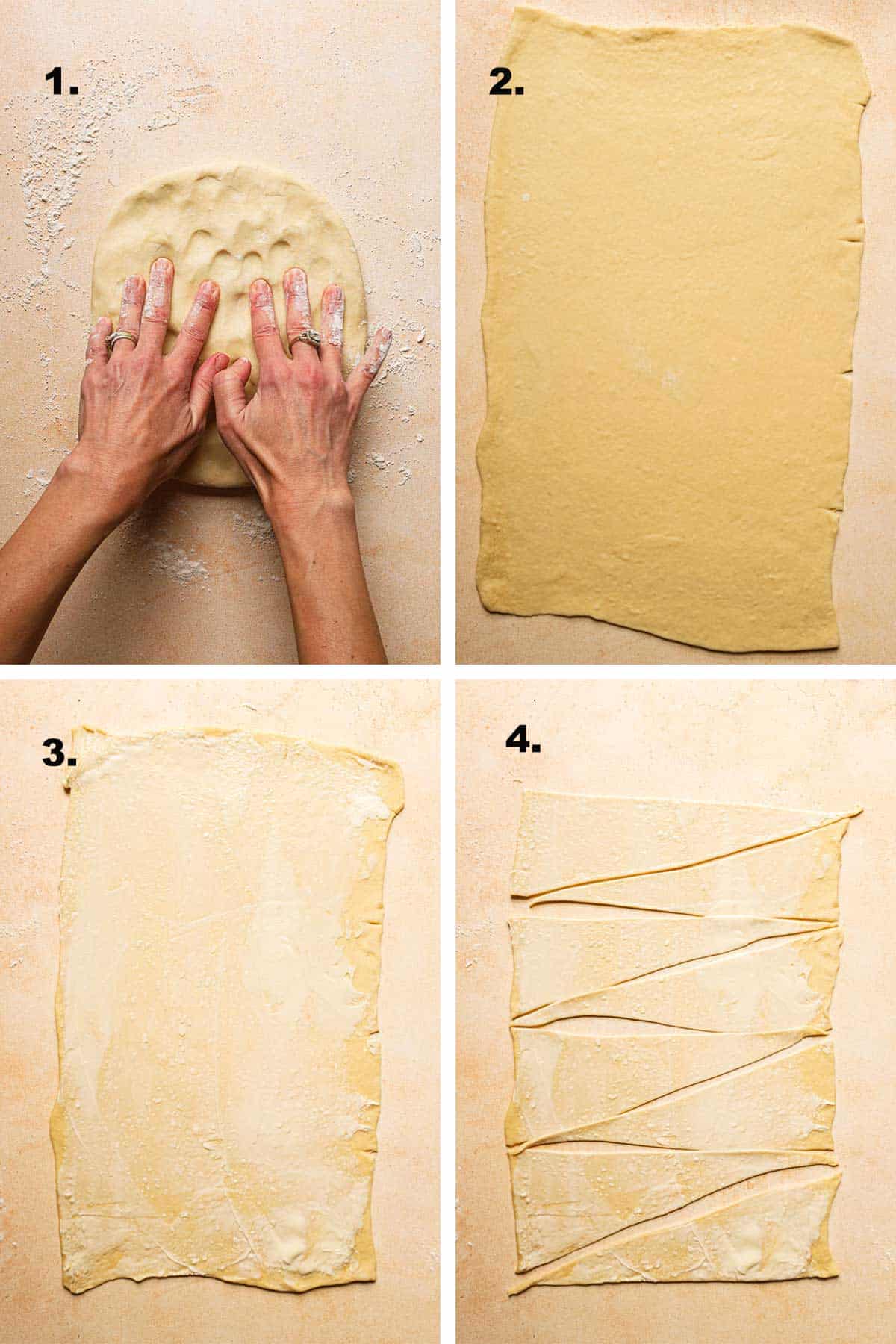
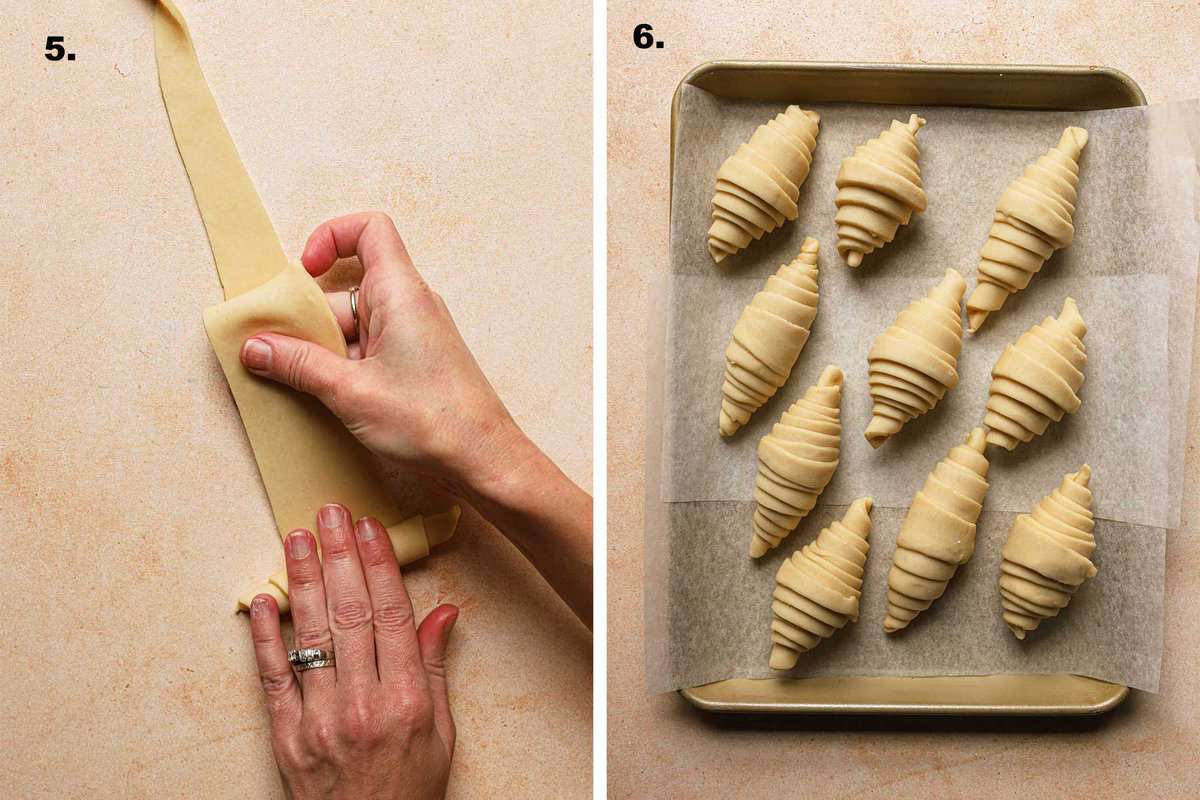
Baking and Soaking
- While the dough rests, place the water, sugar, and vanilla in a medium sauce over medium heat, bring to a boil, then reduce to a simmer and cook for an additional 3-4 minutes.
- Bake the croissant rolls, remove them from the oven, and immediately brush them with the syrup.
Tips and Filling Ideas
- The dough is much easier to handle when cold, so you can allow it to cool in the fridge before shaping. (note that to proof in the fridge, you need 8-10 hours).
- The extra butter we use to spread on the dough will help the croissant become light and slightly flaky. You can skip this it, but know that the rolls will be much richer and denser.
- Do not divide the dough for large pastries and roll it into a 25×16-inch rectangle. Mark the bottom of the wide side into 4-inch segments.
- If you do skip it, slice the bottom of the dough into 2 inches segments.
- Use a ruler to measure the dough for an even crescent shape.
- If the dough is too cold to press, try holding it with your hands and pressing. Or use the palm of your hand.
- Chocolate Filling: Enhance your Brioche Croissants with chocolate spread (like the one I used for this Chocolate Brioche recipe) or Nutella.
- Almond Filling: Add a layer of almond cream and sprinkle sliced almonds before baking.
- Cinnamon Filling. Use the cinnamon filling I used for these Brioche Cinnamon Rolls and these Cinnamon rolls. Or, spread with melted butter and sprinkle a layer of cinnamon sugar.
- Pastry cream and homemade lemon curd.
Storing
These pastries are best eaten right after baking. To maintain the freshness and texture of your Brioche Croissants, store them in an airtight container at room temperature for up to two days.
You can warm them in a 350F preheated oven for 5-10 minutes for a refreshment.
For longer storage, freeze the croissants and reheat them when ready to enjoy.
FAQs
Yes, you can prepare the dough in advance and refrigerate it overnight for a convenient next-day bake.
Absolutely! But note that the pastry will be slightly denser.

More Pastry Recipes You Might Enjoy
Pain Aux Raisin, Cruffins, Almond Cornetto
If you enjoyed this post, please leave a five-star review below the recipe. Don’t forget to tag @OneSarcasticBaker on Instagram whenever you bake this recipe. I would love to see your creations!

Brioche Croissants
Tender and buttery Brioche dough rolled into crescent croissant-shaped rolls.
Ingredients
- 2 Cup Unbleached all-purpose flour (240g)
- 2 Cups Bread flour (240g)
- 2 1/4 teaspoon Instant yeast
- 1 teaspoon Salt
- 1/3 Cup Sugar (70g)
- 2 Large Eggs, at room temperature
- 3/4 Cup Lukewarm water (180ml)
- 1/2 Cup Unsalted butter, soft and cut into 1/2-inch pieces (113g)
- 6-8 Tablespoons Unsalted butter at room temperature (or your choice of filling) (85-113g)
- 1 Large Beaten egg for egg wash
For The Syrup
- 1 Cup Sugar (200g)
- 3/4 Cup Water (180ml)
- 1 teaspoon Vanilla extract
Instructions
-
In a bowl of a stand mixer, place the flour, yeast, salt, and sugar and mix on low. Add the eggs and water.
-
Mix for about three minutes, on medium-low, until you have a dry dough.
-
With the mixer on medium speed, add the butter one 1/2 inch piece at a time, waiting for each piece to mostly incorporate before adding the next.
-
Mix on medium-high speed until the dough leaves the sides of the mixer and you have a soft, elastic dough.
-
Place the dough in a slightly greased bowl, cover with plastic wrap and allow to double in size, in a warm place.
Or, place the dough to rest overnight in the refrigerator.
Shape The Pastries
-
Use your finger to press one-half of the brioche dough into one inch thick, over a lightly floured surface.
-
Using a rolling pin, roll the dough into an 18×9-inch rectangle.
-
Spread four tablespoons of the soft butter over the surface of the dough.
-
Mark the wide bottom part of the dough every 3 inches.
-
Use a sharp knife to cut the dough starting from the three-inch mark towards the corner of the top side in a diagonal and back the same way. Repeat with the rest of the dough.
-
Gently roll each triangle from the wide bottom as you gently stretch the dough.
-
Place the rolled pastries over a baking sheet lined with parchment paper, brush the pastries with the egg wash, and set aside to double in size. About 3-4 hours.
-
Bake at 350F (160C) for 25-30 minutes over the middle oven rack.
-
Remove from the oven and brush with the syrup.
Make The Syrup
-
While the pastries are resting, place the water, sugar, and vanilla in a medium-sized saucepan and cook over medium heat until the sugar dissolves and the water boils.
-
Reduce heat to simmer and cook for an additional 3 minutes.
-
Remove from the stove and set aside until ready to use.
Recipe Notes
- The additional butter spread on the dough is the secret ingredient. It is helping us achieve a light and slightly flaky croissant. Sure, you can choose to skip this step, but be prepared for rolls that lean towards the richer and denser side.
- Use other filling like chocolate spread, nutella, cinnamon filling, or almond cream.
- For larger pastries, refrain from dividing the dough; roll it into a sizable 25×16-inch rectangle. Mark the bottom of the wide side in 4-inch segments.
- However, if you decide to skip the butter layer, simply slice the bottom of the dough into 2-inch segments.
- Use a ruler to measure the dough to ensure an even crescent shape.


Where is the instructions to make the brioche dough?
you can find them under the How to make headlines, and on the recipe card at the bottom of the post.
I see you mentioned all purpose wheat flour at top and down below on the recipe it says all purpose unbleached flour. Which one should I follow?
they are both the same. Use unbleached all-purpose flour (wheat sourced)
Hi Dikla,
If you refrigerate the dough overnight should you bring it to room temperature before rolling?
No need, it is actually much easier to handle the dough when it’s cold.
Looking forward to making these – much easier than a typical Italian cornetti. But if I want to flavor it with something orange, what do you suggest? I once tried making cornetti with some grated orange peel, and they were bitter (I know you want to avoid the white pith). Would orange water work? Thanks very much!
Orange zest sounds great! Just make sure not to over do it, I think zest of half an orange should be fine. And no white part. Personally I love orange water, but it doesn’t really taste like orange, so up to you. Consider maybe flavouring the syrup.